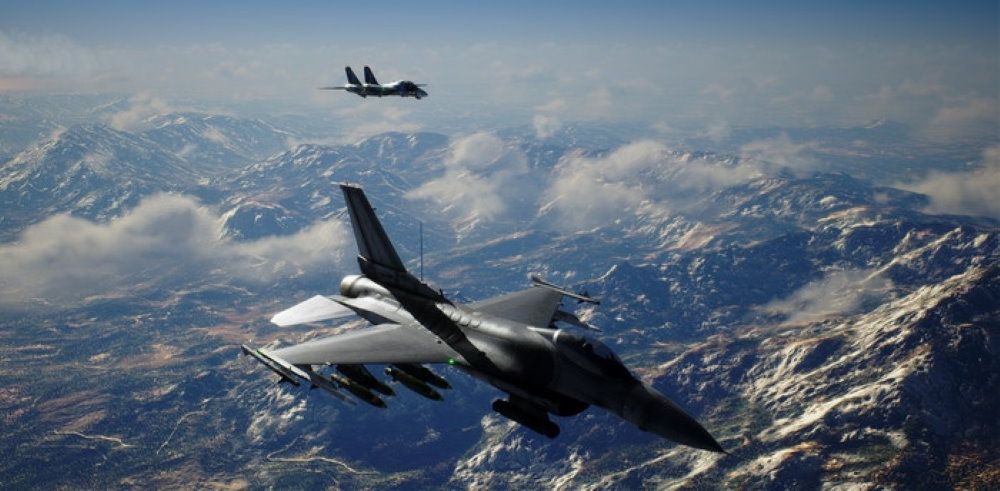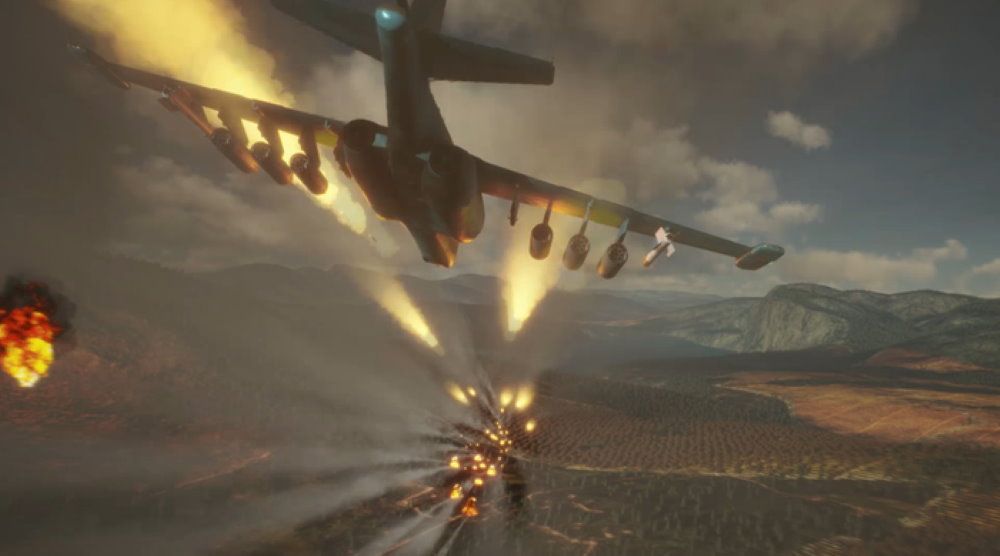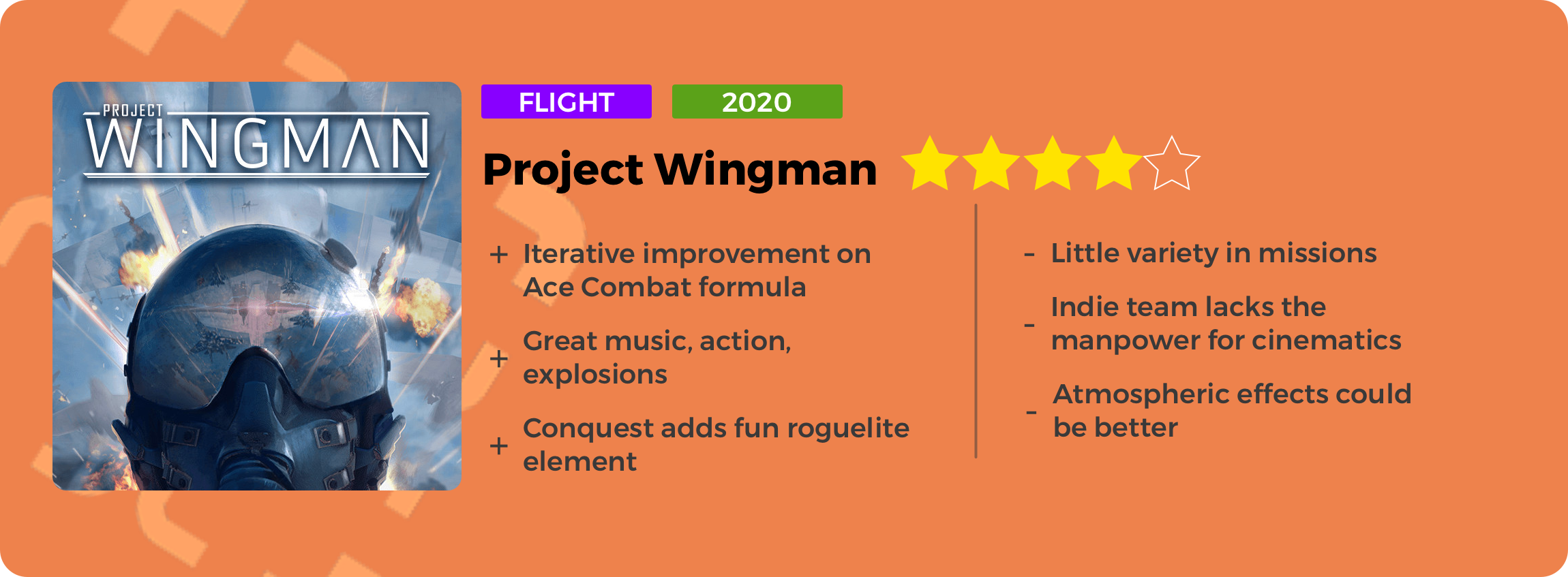Lots of games follow formulas. That’s not a bad thing–formulas help inform the player just what they’re getting into before they even buy a game. Give a player a first-person camera view and a gun, and they know they’re playing a first-person shooter. Add on some random loot generation and an inventory screen, and you’ve got a looter shooter. Throw in a skill tree and an open-world and you’ve got an MMO.
Project Wingman follows the formula written by Bandai Namco’s Ace Combat franchise for the past 25 years. Again, that’s not a bad thing. Developer Sector D2 is completely aware that their audience is filled with Ace Combat fans and catering to those fans would provide them with plenty of eager customers, as evident by Project Wingman’s successful release on Steam and Humble.
Sector D2 is completely unashamed of the fact they’ve made what is essentially an indie Ace Combat game. In fact, there are so many references to previous Ace Combat games in Project Wingman that I could spend this entire article discussing them without ever actually talking about anything else.
The comparison between Project Wingman and Ace Combat is simply unavoidable, so I’m not even going to try. But when making that comparison it’s important to remember that Ace Combat is made by an entire studio backed by Bandai Namco. Project Wingman was mostly made by three dudes working from home. Consequently, there are parts of Project Wingman that are simply not as good as Ace Combat 7, but so much of Project Wingman is just as good–if not better–that I consider it nothing short of a triumph for this very niche genre.
Let’s talk about the Ace Combat formula. Project Wingman calls itself a “flight action game,” but notice there’s no mention of the word “simulation” anywhere. That’s because Project Wingman–like Ace Combat–is about as far removed from reality as you can get.
Project Wingman takes place in an alternate reality 400 years in the future where the Earth has suffered a volcanic apocalypse. In the future, there are lasers and railguns, but for some reason, all these warring nation-states have air forces composed of aircraft that are antiques today, let alone 400 years from now.
Those antique planes are not actually referred to by their real-world names, but that’s probably so Sector D2 can avoid getting sued.
You play as Monarch, a mercenary pilot fighting for the state of Cascadia, which has recently been invaded by an antagonistic Federation. Each mission completed earns you money that can be spent purchasing new aircraft, and each plane comes with its own unique stats like speed and handling, as well as a selection of special weapons that can be added to every aircraft’s standard armament of guns and missiles.
A real jet fighter has enough room for anywhere from six to a dozen missiles or so, depending on the airframe. In Project Wingman, every plane starts with 184 standard missiles and adds between eight and 100 more special weapons. It’s a ludicrous quantity that would turn any real-life aircraft into a missile-coated porcupine that’s so overloaded with armaments that it wouldn’t be able to get off the ground let alone pull high-G aerial maneuvers.
But Project Wingman–like Ace Combat–isn’t about simulating reality. It’s an arcade-style experience designed to make the player feel like a badass fighter pilot without having to worry about pesky little things like fuel, ammunition, or keeping all the blood from rushing out your eyeballs if you were to suddenly dip your nose down while flying at twice the speed of sound.
In Project Wingman, you are a one-man flying army capable of freeing nations and taking down despots single-handedly all without saying a single word. Add in some kickin’ music, a ton of radio chatter, and some realistic-looking fighter jets, and Project Wingman has pretty much nailed the Ace Combat formula.
As I mentioned before, Sector D2 is just three dudes, so they can’t quite nail everything. For example, Ace Combat 7 ties its story together with cinematics that shows characters outside of the cockpit. Project Wingman does what it can with pre and post-mission briefings along with some backstory explained in text files, but there’s not a lot of show to go along with the tell.
Another big difference is the graphics. By and large, Project Wingman is a very pretty game that ensures its planes look great in the waning light of a setting sun, but the same can’t be said for smoke and cloud effects. In Ace Combat 7, I can fly into the upper atmosphere, look down, and see the tops of thunderheads. In Project Wingman, I can sort of see the outline of a cloud-shaped tileset. It’s a little thing, but it’s a reminder that Project Wingman is an indie game that simply doesn’t have the manpower to carefully manicure every fluffy white thing in the sky.
Mission complexity is another space where Project Wingman falls short. Every mission in Project Wingman essentially boils down to “go here, shoot things.” The only variety you get is in the things you shoot, how you shoot them, and why you’re shooting them at all. Now I gotta admit, the most fun I’ve ever had in an Ace Combat mission is when I’m given hundreds of bad guys to shoot, and Project Wingman essentially just gives you a 21-mission campaign of exactly that. But after 21 missions, I find myself in the curious position of almost longing for a civilian aircraft to escort or some reason to fly through a narrow canyon just to break things up.
That said, Project Wingman does a phenomenal job of populating a world where all you do is fly around shooting things. It’s just as satisfying putting a missile up the tailpipe of an enemy fighter in Project Wingman as it is in any previous Ace Combat game. On higher difficulties, enemy fighters can be challenging opponents, and at times the world can be filled with so many missiles and bullets that it takes true skill to survive.
It even improves on the Ace Combat formula in some ways. Something that Ace Combat fans have long asked for is aircraft that can carry multiple different types of special weapons, and Project Wingman lets players do exactly that thanks to an innovative hardpoint and slot system.
Conquest is another interesting addition that strips away the thin veneer of plot and turns Project Wingman into a roguelite. You start with a basic plane and take on wave after wave of enemies until you finally get shot down, then you spend your prestige to try again with a newer, better plane and a few perks. If you’ve always wished there was an Ace Combat game that had the gameplay loop of a roguelite, Project Wingman is here for you.
And there may be more in the future. Sector D2 has made it clear that their current plans are to spend the next little while squashing bugs and making sure everyone’s HOTAS and VR setups work exactly as promised, but after that, the sky’s the proverbial limit. I don’t think we’ll see anything as complex as a multiplayer mode (especially given how Project Wingman’s aircraft aren’t balanced to fly against one another), but DLC planes certainly seem within the realm of possibility.
I am unabashedly, unreservedly enjoying Project Wingman. The game runs beautifully, and I haven’t run into any bugs or issues. It’s just one mission after the other of flying cool planes into battle again and again. And although the technical part of my brain acknowledges the relatively minor deficiencies of Project Wingman compared to Ace Combat 7, the lizard part of my brain–the part that goes all tingly every time there’s a huge explosion–doesn’t care.
Project Wingman is a distillation of the Ace Combat formula. It cuts out all the extra window dressing that was nice to have but was never strictly necessary. It is both a love letter to the franchise and at times even shows Ace Combat a thing or two.
I think I’ve sunk about 250 hours into Ace Combat 7. Most of that was spent just endlessly replaying the campaign with as many different aircraft as were available. I’m not sure yet if I’m going to play Project Wingman for quite as long, but given how I’ve lost sleep all week just so I could play one more mission, I suspect I might come close.
A PC copy of Project Wingman was provided to TheGamer for this review. Project Wingman is available now for PC.
NEXT: Simultaneous Updates Across All Platforms Are A “High Goal” For Warframe In 2021
- Game Reviews
- Project Wingman
Actually a collective of 6 hamsters piloting a human-shaped robot, Sean hails from Toronto, Canada. Passionate about gaming from a young age, those hamsters would probably have taken over the world by now if they didn’t vastly prefer playing and writing about video games instead.
The hamsters are so far into their long-con that they’ve managed to acquire a bachelor’s degree from the University of Waterloo and used that to convince the fine editors at TheGamer that they can write “gud werds,” when in reality they just have a very sophisticated spellchecker program installed in the robot’s central processing unit.
Source: Read Full Article





